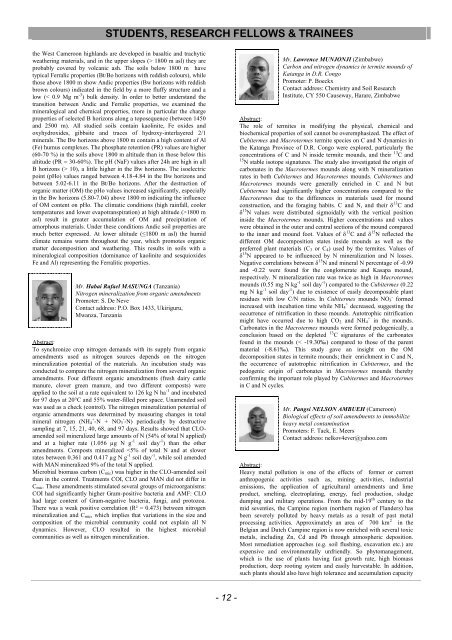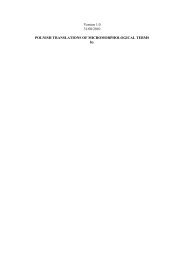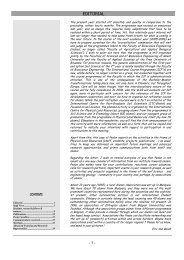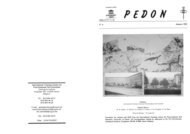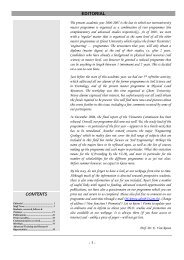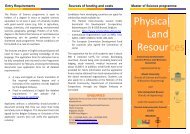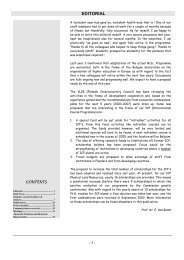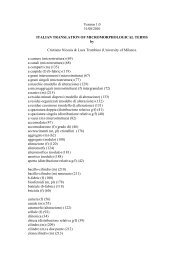Pedon 23 - Physical Land Resources - Universiteit Gent
Pedon 23 - Physical Land Resources - Universiteit Gent
Pedon 23 - Physical Land Resources - Universiteit Gent
Create successful ePaper yourself
Turn your PDF publications into a flip-book with our unique Google optimized e-Paper software.
STUDENTS, RESEARCH FELLOWS & TRAINEES<br />
the West Cameroon highlands are developed in basaltic and trachytic<br />
weathering materials, and in the upper slopes (> 1800 m asl) they are<br />
probably covered by volcanic ash. The soils below 1800 m have<br />
typical Ferralic properties (Bt/Bo horizons with reddish colours), while<br />
those above 1800 m show Andic properties (Bw horizons with reddish<br />
brown colours) indicated in the field by a more fluffy structure and a<br />
low (< 0.9 Mg m -3 ) bulk density. In order to better understand the<br />
transition between Andic and Ferralic properties, we examined the<br />
mineralogical and chemical properties, more in particular the charge<br />
properties of selected B horizons along a toposequence (between 1450<br />
and 2500 m). All studied soils contain kaolinite, Fe oxides and<br />
oxyhydroxides, gibbsite and traces of hydroxy-interlayered 2/1<br />
minerals. The Bw horizons above 1800 m contain a high content of Al<br />
(Fe) humus complexes. The phosphate retention (PR) values are higher<br />
(60-70 %) in the soils above 1800 m altitude than in those below this<br />
altitude (PR = 30-60%). The pH (NaF) values after 24h are high in all<br />
B horizons (> 10), a little higher in the Bw horizons. The isoelectric<br />
point (pHo) values ranged between 4.18-4.84 in the Bw horizons and<br />
between 5.02-6.11 in the Bt/Bo horizons. After the destruction of<br />
organic matter (OM) the pHo values increased significantly, especially<br />
in the Bw horizons (5.80-7.04) above 1800 m indicating the influence<br />
of OM content on pHo. The climatic conditions (high rainfall, cooler<br />
temperatures and lower evapotranspiration) at high altitude (>1800 m<br />
asl) result in greater accumulation of OM and precipitation of<br />
amorphous materials. Under these conditions Andic soil properties are<br />
much better expressed. At lower altitude (≤1800 m asl) the humid<br />
climate remains warm throughout the year, which promotes organic<br />
matter decomposition and weathering. This results in soils with a<br />
mineralogical composition (dominance of kaolinite and sesquioxides<br />
Fe and Al) representing the Ferralitic properties.<br />
Mr. Habai Rafael MASUNGA (Tanzania)<br />
Nitrogen mineralization from organic amendments<br />
Promoter: S. De Neve<br />
Contact address: P.O. Box 1433, Ukiriguru,<br />
Mwanza, Tanzania<br />
Abstract:<br />
To synchronize crop nitrogen demands with its supply from organic<br />
amendments used as nitrogen sources depends on the nitrogen<br />
mineralization potential of the materials. An incubation study was<br />
conducted to compare the nitrogen mineralization from several organic<br />
amendments. Four different organic amendments (fresh dairy cattle<br />
manure, clover green manure, and two different composts) were<br />
applied to the soil at a rate equivalent to 126 kg N ha -1 and incubated<br />
for 97 days at 20°C and 55% water-filled pore space. Unamended soil<br />
was used as a check (control). The nitrogen mineralization potential of<br />
organic amendments was determined by measuring changes in total<br />
mineral nitrogen (NH + 4 -N + NO - 3 -N) periodically by destructive<br />
sampling at 7, 15, 21, 40, 68, and 97 days. Results showed that CLOamended<br />
soil mineralized large amounts of N (54% of total N applied)<br />
and at a higher rate (1.056 µg N g -1 soil day -1 ) than the other<br />
amendments. Composts mineralized


